Archive for the 'Board Game Review' Category
Posted by James (admin) on 20th January 2014
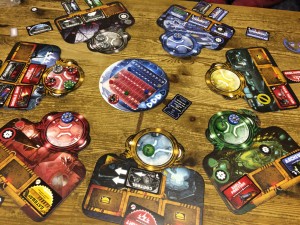
Theseus is a sci-fi game set on a space station where the different factions (soldiers, scientists, aliens and greys) are trying to take control. The setting and photos may give the impression it’s a complicated game, but it’s actually a eurogame that is relatively quick and contains some good tactical play.
THE GAME
Players take turns moving their units around different locations (sectors) on the space station. Each sector is a separate board piece and these are arranged in a circle: one sector for each player’s faction, plus one each for the Corridors, Control Room and Tech Bay. Each sector has 4 rooms (in the circular area) as well as several spaces for action cards (the oblong areas) which players will place during the game. Each player has their own unique deck of action cards. These first enter the game by being placed next to sectors (called ‘pending’ cards) which may get to be placed (‘installed’) on a sector later.
On their turn, a player must move one of their 3 units a number of sectors clockwise equal to the number of units currently on the unit’s starting sector, i.e. if there are 2 units on a sector, then a unit moved from there moves 2 sectors clockwise. A moved unit is placed in one of the 4 rooms (arranged in a 2 x 2 grid) on the sector they move to. Some rooms have walls between them which block combat. If all 4 rooms are full, the arriving player ejects one of the units there into space and takes their position. If a unit’s move means all the rooms in the sector are now full, all units belonging to the player whose turn it is attack other units in that sector. (Only soldiers start with combat ability; whereas, other factions’ units need upgrading first.) Read the rest of this entry »
Tags: board game news, Board Games, board gaming, Essen, Portal Publishing, Spiel 13, Spiel 2013, Theseus
Posted in Board Game Review, Board Games, Essen Spiel 13, Spiel 2013, Theseus | 1 Comment »
Posted by James (admin) on 18th December 2013
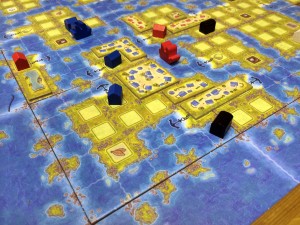 Amerigo is a game by Stefan Feld – a designer who has created some great game such as Bora Bora, Rialto, Trajan, Strasbourg, Die Speicherstadt to name just some that I’ve reviewed.
Amerigo is a game by Stefan Feld – a designer who has created some great game such as Bora Bora, Rialto, Trajan, Strasbourg, Die Speicherstadt to name just some that I’ve reviewed.
THE GAME
Like two other Queen Games (Shogun and Wallenstein), Amerigo uses a cube tower – a card tower with couple of card sections inside (like floors in a building) which have various holes in them. When cubes are dropped into the tower, some come out at the bottom and some are retained inside the tower on the card layers (which may fall out when more cubes are dropped into the tower later).
Made up of multiple tile sections, the board show grids of land and water spaces and, together, form islands. During the game, players explore and colonise islands by moving their ships, setting up trading posts and building villages. Players score Victory Points (VPs) for building villages, gathering goods (and increasing the value of their goods), developments, etc. The game lasts 5 rounds (each divided into 7 phases) and the player with most VPs at the end of the game wins.
So far, it sounds fairly standard but the core game mechanic – the action system – driving Amerigo is nicely different. There are 7 different actions that a player can take and each corresponds to a specific colour of cubes: Sail and place trading posts (Blue), Gain cannon (Black), Buy building tiles (Red), Development (Brown), Place building tiles (Green), Improve trade good values (Yellow), and Special (White). Read the rest of this entry »
Tags: Amerigo, board game news, Board Games, board gaming, Essen, Spiel 13, Spiel 2013, Stefan Feld
Posted in Amerigo, Board Game Review, Board Games, Essen Spiel 13, Spiel 2013 | 2 Comments »
Posted by James (admin) on 13th December 2013
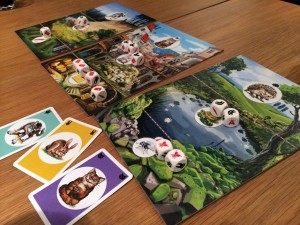
Om Nom Nom is a very quick and light game of predicting what other players will do. On the table are 3 boards showing a different set of animals/food in predatory order: Wolf/Rabbit/Carrots, Cat/Mouse/Cheese and Hedgehog/Frog/Fly. So, at the top is the main predator, below it is the predator’s food, and below that is the predator’s food’s food.
At the start of a round, 15 dice are rolled which have the 6 foods on them (rabbit, carrot, mouse, cheese, frog, fly) and these are placed on the relevant board areas. Each player starts each round with 6 cards – one for each animal (wolf, rabbit, cat, mouse, hedgehog, frog) and each card can only be played once during a round. There are 6 turns in a round and, each turn, all players play 1 of their cards by revealing them simultaneously. Players playing an animal which has food below it share the food evenly (discarding any that can not be shared evenly) – rabbits, mice and frogs are each worth 1 point; whereas, carrots, cheese and flies are each worth 2 points. (Note that rabbit, mice and frog cards that players play also count as food so can be eaten too.)
However, there’s a catch: The eating gets resolved from top to bottom on each board. This means a predator at the top of a board may eat the animal below it before that lower animal gets a chance to eat the food below them. In the photo above, if player A played a hedgehog and player B played a frog, then player A would eat player B’s frog along with the 2 frogs on the dice and this would happen before player B’s frog gets a chance to eat the flies. You score 1 point for each of your own animal cards that didn’t get eaten when played. Most points after 3 rounds wins.
Read the rest of this entry »
Tags: board game news, Board Games, board gaming, Essen, Om Nom Nom, Spiel 13, Spiel 2013
Posted in Board Game Review, Board Games, Essen Spiel 13, Om Nom Nom, Spiel 2013 | No Comments »
Posted by James (admin) on 12th December 2013
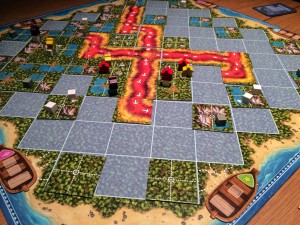 Mauna Kea is a game about explorers fleeing from an erupting volcano. This is not a co-operative game so players will be stepping over each other to take the boats along with as many artifacts as they can with them.
Mauna Kea is a game about explorers fleeing from an erupting volcano. This is not a co-operative game so players will be stepping over each other to take the boats along with as many artifacts as they can with them.
THE GAME
The board starts with many blank areas and the landscape will get filled in during the game. Landscape tiles (which get drawn from a bag) display 4 smaller squares which can each be of a different terrain type, plus each tile shows a number of movement points too.
Each turn, a player draws tiles from the bag until they have a total of 5 or more movement points. On their turn, players must use their tiles either for movement points to move their explorers, or for placing on blank areas of the board to reveal the landscape. Tiles with lava don’t count towards the player’s tiles and are immediately added to the matching lava flow (there are 4 different flows from the central volcano) and an arrow shows the direction too. Sometimes the lava flows split too.
Moving through water spaces costs more movement points than moving through jungle areas, and spaces containing mountains and lava block movement.
Read the rest of this entry »
Tags: board game news, Board Games, board gaming, Essen, Huch, Mauna Kea, Spiel 13, Spiel 2013
Posted in Board Game Review, Board Games, Essen Spiel 13, Mauna Kea, Spiel 2013 | No Comments »
Posted by James (admin) on 10th December 2013
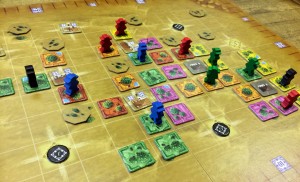 Citrus is a eurogame by Jeffrey D Allers who has created some great games such as Alea Iacta Est and Sahne (Piece o’Cake).
Citrus is a eurogame by Jeffrey D Allers who has created some great games such as Alea Iacta Est and Sahne (Piece o’Cake).
THE GAME
During the game, players buy and place different fruit plantations (coloured tiles) in order to build groups of plantation tiles. The main board shows farming land (grid) with several fincas (buildings) and locations where fincas will be built later. Each turn, a player can either Build or Harvest.
Building
When a player builds, they buy plantation tiles from the market board, which is an odd-shaped grid, and pay 1 coin per tile. However, the player must (a) buy all the tiles in a single row on the market grid and (b) must be able to place all the tiles they buy (as players can’t hold onto tiles in between turns). As soon as the market is left with 3 or fewer tiles on it, it is re-filled and a new finca is added. (The player that triggered this chooses on which of the 4 building sites the new finca is placed and a new building site is added to the remaining ones).
Read the rest of this entry »
Posted in Board Game Review, Board Games, Citrus, Essen Spiel 13, Spiel 2013 | No Comments »
Posted by James (admin) on 5th December 2013
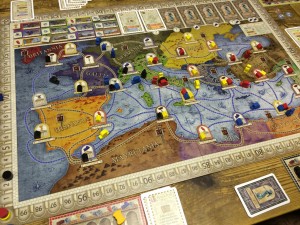
Concordia is a Roman-themed game by Mac Gerdts, known for his rondel game mechanic games such as Navegador and Imperium. However, Concordia doesn’t use the rondel mechanic (Gerdts has made a non-rondel game before too); instead, it uses cards for both actions and scoring.
The main board shows Europe (3-5 players) or Italy (2-4 players) which is divided into provinces and each province contains several cities. The type of good that each city produces (bricks, food, tools, wine, cloth) is determined at the start of the game which adds some variety in replay.
Players have land and sea colonists which they can move around the board via the land or sea routes that connect the cities. Players take turns playing one of their cards from their hand and carrying out the specific action on it.
- Architect: Move colonists then spend resources and cash to build houses at cities at end of any route their colonists occupy
- Prefect: Generate resources in a region or cash
- Colonist: Generate cash, or spend resources to place new colonists
- Mercator: Receive cash and then buy/sell 2 types of goods
- Senator: Spend resources to purchase up to 2 of the 7 cards on display
- Consul: Spend resources to purchase 1 of the 7 cards on display (usually cheaper than using a Senator)
- Specialists: Generate one type of resource
- Diplomat: Do the action that is another player’s most recently played card
- Tribune: All played cards return to your hand (gain 1 cash for each card minus 3) and can spend resources to place 1 new colonist.
Read the rest of this entry »
Tags: board game news, Board Games, board gaming, Concordia, Essen, Mac Gerdts, PD Verlag, Spiel 13, Spiel 2013
Posted in Board Game Review, Board Games, Concordia, Essen Spiel 13, Navegador, Spiel 2013 | No Comments »
Posted by James (admin) on 4th December 2013
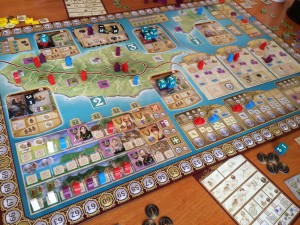
This is the main game board. There is also a small board (the Guild Board) too.
What’s Your Game have released some excellent games like Vasco de Gama and last year’s superb (and undeservedly less-known) Oddville. This year’s game, Madeira, is a very meaty eurogame – none of the game mechanics are complicated, but there are lots of them and they are quite interwoven.
THE GAME
Each round, players select a set of action dice which they place to use on the character’s actions, and potentially the building’s actions too. As well as cash and various resources, players have workers and ships which can be moved to various areas of the board. When triggered, workers on fields harvest that field’s resource, workers in colonies generate resources each round, and workers in cities can generate cash, food or bread. (Workers can also be in the city watch area.) Ships moved to markets and colonies can exchange resources for cash and special abilities respectively.
The board shows 5 buildings and some islands areas (located in 3 regions) and each building has a character on it too. The characters move during the game so are not always paired with the same buildings each round.
The game is played over 5 rounds. At the start of each round, each player selects a row on the Guild Board and takes the 3 dice next to it (which have already been rolled – values are 1, 2 or 3). Plus, the player selects one of the remaining Crown Request tiles in the same row – these earn points at the end of some rounds. The row selected also determines turn order for the next phase, plus it allows the player to reactivate some guild favours (special abilities) if they have any that match the row’s colour.
Read the rest of this entry »
Tags: board game news, Board Games, board gaming, Essen, Madeira, Spiel 13, Spiel 2013, What's Your Game
Posted in Board Game Review, Board Games, Essen Spiel 13, Madiera, Spiel 2013 | 1 Comment »
Posted by James (admin) on 2nd December 2013
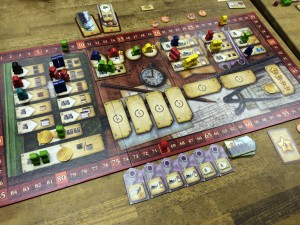
The main game board at game end. The large pale yellow oblong spaces are where the engineers are located during the game.
Russian Railroads is a meaty, worker-placement eurogame. As you may expect from the title, players compete to construct the best railroads across Russia.
THE GAME
Unlike many railway-building games, there is no map to build across; however, this isn’t a hindrance and actually makes the game different to other games. There is a central game board where players place their workers to take actions, plus each player has their own player boards to track their progress.
Each round, players take turns allocating their workers (cool-looking meeple with Russian hats) to various actions on the main game board. For example, players can lay track which advances the relevant matching colour rail marker(s) along any of the 3 routes on their player boards. There are 5 colours of track marker in the game (each route requiring a different mixture of track marker colours) but these colour markers are not allowed to pass one another or occupy the same space, so this means you need to consider the order in which you advance the track markers too. Read the rest of this entry »
Tags: board game news, Board Games, board gaming, Essen, Russian Railroads, Spiel 13, Spiel 2013, Z-Man Games
Posted in Board Game Review, Board Games, Essen Spiel 13, Russian Railroads, Spiel 2013 | No Comments »
Posted by James (admin) on 30th November 2013
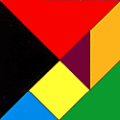 Now that the dust has settled following Spiel in Essen (due to work, sickness, voting on some awards, and life in general), I am finally able to start writing reviews of the games released this year. Unlike other years, I didn’t get to play many of the big releases until after Spiel, rather than during it; however, I have played many now (and there’s still a sizeable pile still to play too) and can report there were loads of great games this year.
Now that the dust has settled following Spiel in Essen (due to work, sickness, voting on some awards, and life in general), I am finally able to start writing reviews of the games released this year. Unlike other years, I didn’t get to play many of the big releases until after Spiel, rather than during it; however, I have played many now (and there’s still a sizeable pile still to play too) and can report there were loads of great games this year.
However, in advance of all the full reviews, I thought I’d post briefly about what I’ve played so far. Last week, was a busy week with a chance to play a lot of games. I’ve played Russian Railroads with 2 and 4 players now and it’s an excellent meaty eurogame with some pretty tough decisions, especially as there are lots of possible ways to make points but spreading yourself too thinly across a lot of them is not likely to turn out so well. S0, you need to have a plan as well as a plan on what to do if progressing the first plan isn’t possible because other players get in the way. Read the rest of this entry »
Tags: Amerigo, board game news, Board Games, board gaming, Citrus, Cruel Necessity, Essen, Freedom, Lewis and Clark, Madeira, Nations, Russian Railroads, Spiel 13, Spiel 2013
Posted in Amerigo, Board Game Review, Board Games, Citrus, Cruel Necessity, Essen Spiel 13, Freedom, Lewis and Clark, Madiera, Nations, Russian Railroads, Spiel 2013 | No Comments »
Posted by James (admin) on 18th October 2013
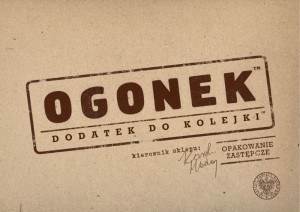 Ogonek (which means ‘Line’) is the expansion for one of my favourite games Kolejka (meaning ‘Queue). Kolejka is a game where players are queuing for goods at shops in 1980’s Poland. As crazy as it sounds, it’s a superb game and a very historical theme. For more details on Kolejka see my full review.
Ogonek (which means ‘Line’) is the expansion for one of my favourite games Kolejka (meaning ‘Queue). Kolejka is a game where players are queuing for goods at shops in 1980’s Poland. As crazy as it sounds, it’s a superb game and a very historical theme. For more details on Kolejka see my full review.
Ogonek adds a few new elements to the game. One item is that it adds the potential for a 6th player (as Kolejka is 2-5 players) which is a welcome addition. Having 6 players adds a bit more chaos into proceedings than with fewer players as more things can happen to your plans between your turns.
Ogonek adds alcohol as a new item. Rather than having to queue at shops for this, players can place one of their queuers on one of the available alcohol goods cards at the side of the board. At the end of the round, the player receives the alcohol (so it’s not usable in the round they obtain it). Alcohol can be used to bribe the speculators (the neutral queuers that get in the way) which allows the player to swap places with them in the same queue. Alcohol can also be used as a substitute item when swapping goods at the market. So, alcohol is useful but too powerful.
Read the rest of this entry »
Tags: board game news, Board Games, board gaming, Kolejka, Ogonek, Strajk
Posted in Board Game Review, Board Games, Ogonek (Line) | No Comments »











